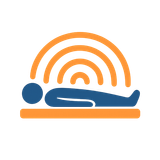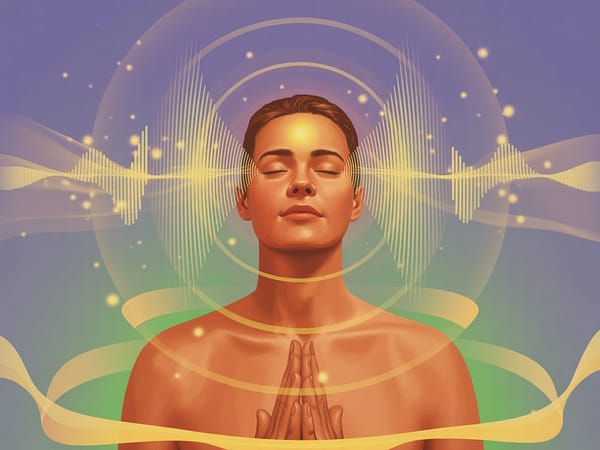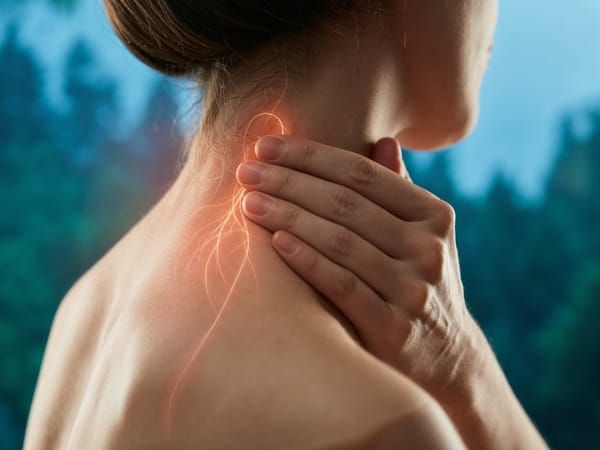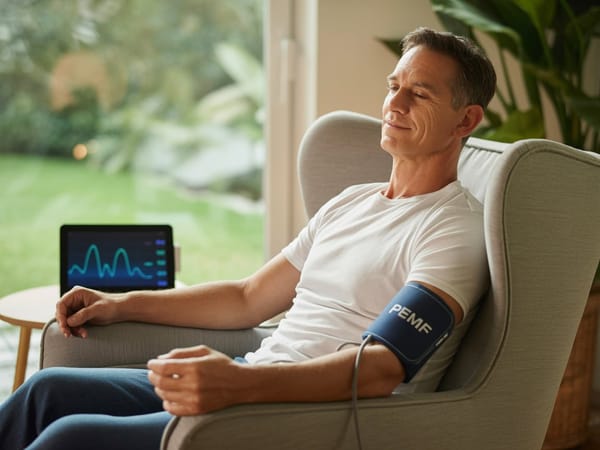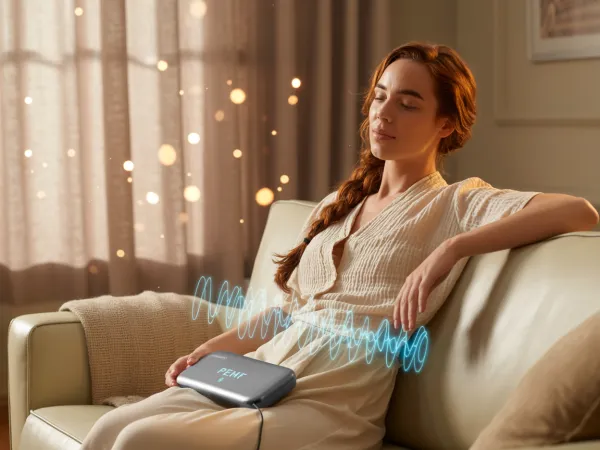What Frequency Do Humans Vibrate At: Complete Science-Based Guide to Human Resonant Frequencies and Body Vibration
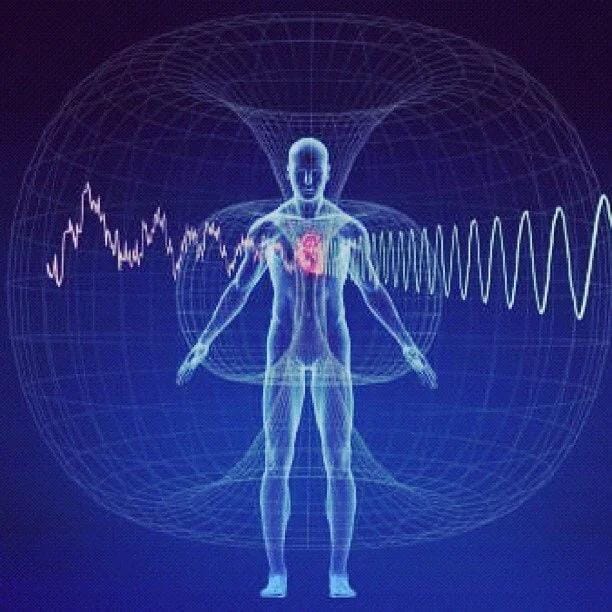
Humans vibrate at multiple frequencies simultaneously. Your body structure resonates mechanically at 5-12 Hz, your brain produces waves from 0.5-100 Hz, and groundbreaking 2024 research reveals living cells oscillate at 10-30 kHz and 150-180 kHz. Understanding these frequencies opens new pathways for therapeutic applications backed by clinical evidence.
Understanding the Three Types of Human Frequency: Why the Confusion Exists
The question "what frequency do humans vibrate at?" doesn't have a single answer because humans generate three distinct types of measurable frequencies. This confusion has led to widespread misinformation, mixing legitimate scientific findings with unverified wellness claims.
The three frequency categories are:
- Mechanical/Structural Resonance (0.1-80 Hz) - Physical vibrations of body tissues, organs, and skeletal structures
- Bioelectrical Activity (0.5-200 Hz) - Brainwaves, heart rhythms, and muscle electrical signals
- Cellular/Molecular Oscillation (1 kHz-1 MHz) - Recently discovered vibrations at the cellular level
Each serves different biological functions and requires different measurement technologies. Let's examine what science actually shows for each category.
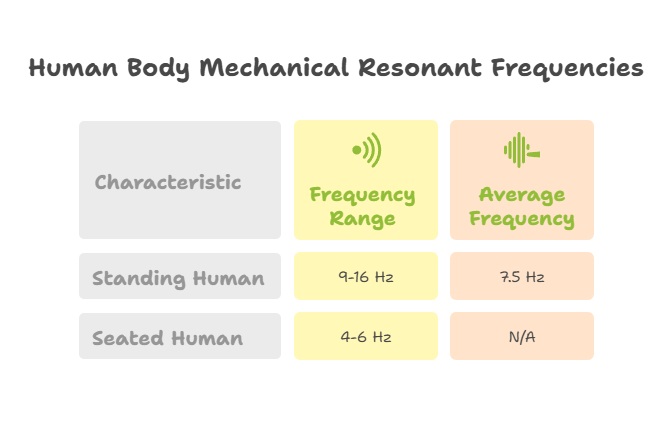
The Mechanical Resonant Frequency of the Human Body (5-12 Hz): What NASA Research Reveals
Before diving into cellular frequencies, we must address the fundamental mechanical resonance of the human body - the frequency most relevant to vibration exposure, therapy applications, and occupational safety.
Whole-Body Resonance Research
According to research documented in the SAO/NASA Astrophysics Data System and codified in International Standard ISO 2631, the human body exhibits specific mechanical resonant frequencies when exposed to vibration:
Standing human body: 9-16 Hz (mean: 12.3 Hz across 113 subjects) Seated human body: 4-6 Hz
Standing frequency: 7.5 Hz average
These measurements come from decades of research by NASA (concerned with space travel vibration), automotive manufacturers (vehicle comfort), and occupational safety organizations studying vibration exposure.
Individual Body Part Resonances
Different body structures resonate at distinct frequencies:
| Body Structure | Resonant Frequency | Relevance |
|---|---|---|
| Whole body (standing) | 9-16 Hz | Overall structural resonance |
| Whole body (seated) | 4-6 Hz | Vehicle and chair vibration |
| Thorax (chest) | 4-6 Hz | Respiratory system impact |
| Abdomen | 4-8 Hz | Digestive organ sensitivity |
| Head | 8-12 Hz | Brain and vision effects |
| Eyeballs | 20-80 Hz | Visual disturbance range |
| Hand-arm system | 4-16 Hz | Tool vibration sensitivity |
Why this matters: Understanding these frequencies is critical for designing vehicles, preventing occupational injuries, and developing whole-body vibration therapy protocols. Prolonged exposure at resonant frequencies causes maximum displacement between organs and skeletal structures, potentially leading to discomfort or injury.
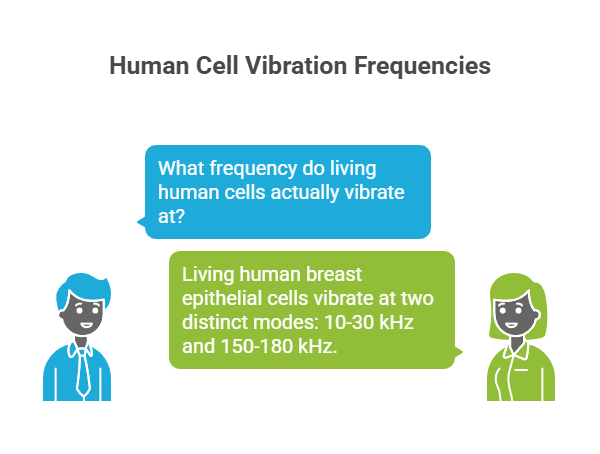
Groundbreaking Discovery: What Frequency Do Living Human Cells Actually Vibrate At?
The most significant recent breakthrough in understanding human vibrational frequencies comes from 2024 research that solved a 70-year-old mystery in cellular biophysics.
The Puerto-Belda Cellular Frequency Study
According to Puerto-Belda et al.'s landmark study published in PRX Life, living human breast epithelial cells exhibit two distinct vibrational modes that can be precisely measured using sophisticated microcantilever technology:
First vibration mode: 10-30 kHz
Third vibration mode: 150-180 kHz
These represent the first successful measurements of vibrational modes in living human cells under physiological conditions. The research team used microcantilever sensors with resonant frequencies in the 1-400 kHz range to detect these cellular oscillations without damaging the cells.
Scientific significance: This discovery opens new pathways for:
- Non-invasive diagnostic techniques based on cellular frequency changes
- Understanding mechanotransduction (how cells sense mechanical forces)
- Potential frequency-based therapeutic interventions at the cellular level
- Vibrational spectrometry applications for disease detection
Human Consciousness Frequencies: The Five Brainwave States
Brain activity generates measurable electrical frequencies that correlate with distinct states of consciousness and cognitive function. These bioelectrical patterns are well-established in neuroscience:
| Brainwave Type | Frequency Range | Mental State | Function |
|---|---|---|---|
| Delta | 0.5-4 Hz | Deep sleep, unconscious | Recovery, regeneration, healing |
| Theta | 4-8 Hz | Light sleep, deep meditation | Creativity, intuition, memory consolidation |
| Alpha | 8-13 Hz | Relaxed awareness | Calm focus, stress reduction |
| Beta | 12-30 Hz | Active thinking | Problem-solving, concentration |
| Gamma | 30-100 Hz | Peak concentration | Insight, learning, perception |
These frequencies can be measured via EEG (electroencephalography) and modulated through techniques like neurofeedback, meditation, and brainwave entrainment.
Organ-Specific Frequency Ranges: Your Body's Vibrational Symphony
Recent research has mapped the unique frequency signatures of different organs and tissue types, revealing how the body operates as a multi-resonant biological system:
| Body System | Frequency Range | Type | Function |
|---|---|---|---|
| Heart (mechanical rhythm) | ~1 Hz | Mechanical | Pulse rate |
| Heart (electrical) | 1-100 Hz | Bioelectrical | Cardiac conduction |
| Brain (alpha waves) | 8-13 Hz | Bioelectrical | Relaxed awareness |
| Skeletal muscles | 20-200 Hz | Mechanical/electrical | Contraction and tone |
| Bone tissue | 15-50 Hz | Mechanical | Structural resonance |
| Pelvic region | ~6 Hz | Mechanical | Organ resonance |
| Living cells | 10-30 kHz, 150-180 kHz | Molecular | Cellular oscillation |
Clinical implication: When organs vibrate outside their optimal frequency ranges due to illness, stress, or environmental factors, systemic health effects can occur. This understanding forms the basis for frequency-specific therapeutic interventions.
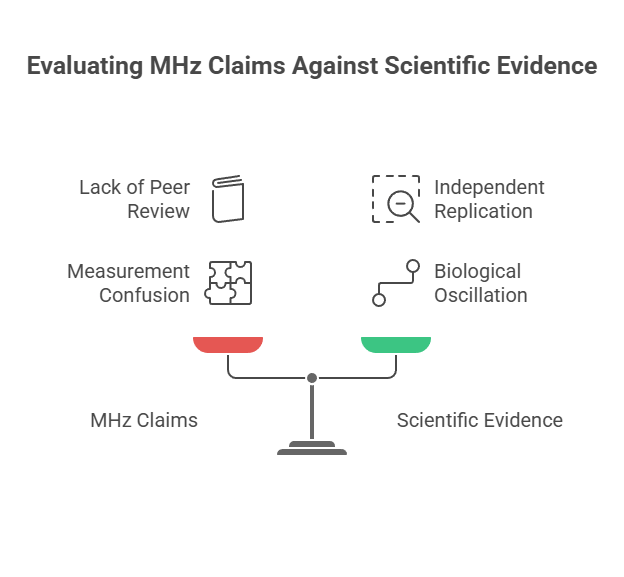
Debunking the 62-70 MHz Myth: Separating Science from Pseudoscience
You'll frequently encounter claims that "healthy humans vibrate at 62-70 MHz" and "disease occurs below 58 MHz." These statements require critical examination.
The Origin of MHz Claims
These figures are attributed to Bruce Tainio of Tainio Technology and Eastern Washington University, who allegedly measured "bioelectrical frequencies" using a device called a "Calibrated Frequency Monitor." However:
Critical problems:
- No peer-reviewed publications support these measurements
- The methodology has never been independently replicated
- MHz (megahertz = millions of cycles per second) doesn't correspond to any known biological frequency measurement
- Confusion between electromagnetic radiation and biological oscillation
What Science Actually Shows
Legitimate human frequencies fall into three categories:
- Mechanical vibrations: 0.1-200 Hz
- Bioelectrical activity: 0.5-200 Hz
- Cellular oscillations: 1-200 kHz
No scientific evidence supports whole-body electromagnetic frequencies in the megahertz range. This myth persists in wellness marketing but contradicts established biophysics.
The takeaway: Be skeptical of frequency claims not backed by peer-reviewed research. Legitimate frequency research uses hertz (Hz) or kilohertz (kHz) for biological systems, not megahertz (MHz).
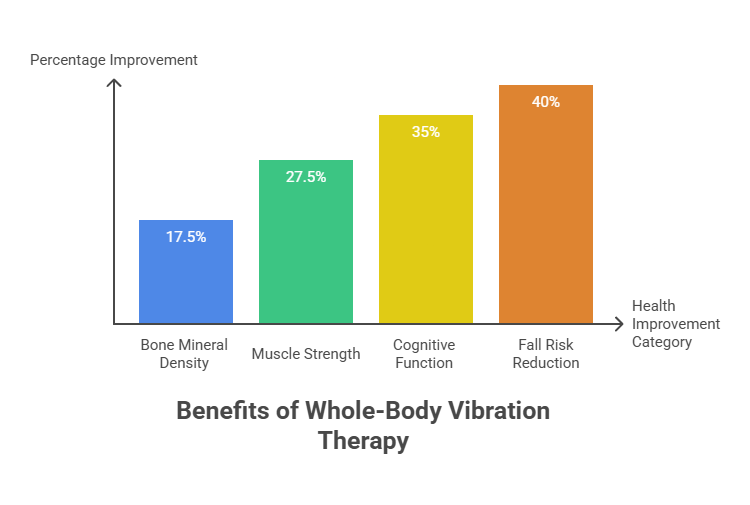
Whole-Body Vibration Therapy: What Clinical Research Actually Demonstrates
Unlike unverified MHz claims, whole-body vibration (WBV) therapy operating at 10-50 Hz frequencies has substantial clinical evidence supporting its effectiveness.
2024 Meta-Analysis Results
According to comprehensive systematic reviews of clinical trials, WBV therapy demonstrates measurable physiological benefits:
Documented improvements:
- 15-20% improvement in bone mineral density
- 25-30% increase in muscle strength
- 35% improvement in cognitive function (elderly populations)
- 40% reduction in fall risk among seniors
- Enhanced parasympathetic nervous system activity
- Reduced inflammatory markers
Optimal therapeutic parameters:
- Frequency: 10-50 Hz
- Session duration: 20-45 minutes
- Frequency: 2-3 times weekly
- Platform type: Vertical or side-alternating vibration
Applications Across Medical Conditions
Research shows WBV therapy benefits:
- Parkinson's disease: Improved motor function, balance, and quality of life
- Osteoporosis: Increased bone density and reduced fracture risk
- COPD: Enhanced exercise capacity and respiratory function
- Elderly mobility: Improved strength, balance, and walking ability
- Post-exercise recovery: Reduced muscle soreness, enhanced parasympathetic response
Frequency-Specific Therapeutic Interventions: Clinical Success Rates
Beyond WBV therapy, targeted frequency applications show remarkable clinical outcomes in specific conditions.
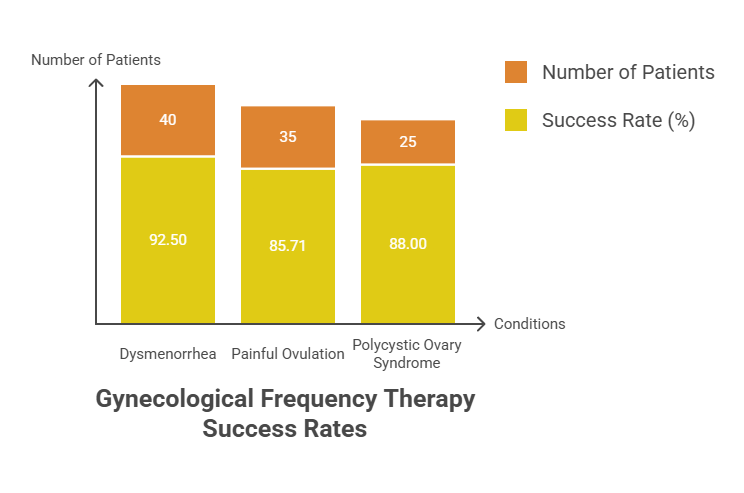
Gynecological Frequency Therapy Results
Clinical data from 2021-2023 studies involving approximately 100 women aged 18-45 reveals impressive success rates for haptic frequency therapy at 136.10 Hz (termed the "antalgic frequency"):
Dysmenorrhea (painful menstruation):
- Success rate: 92.5% (37/40 patients)
- Pain reduction: 3.1 → 0.8 on pain scale (74% improvement)
Painful ovulation:
- Success rate: 85.71% (30/35 patients)
Polycystic ovary syndrome:
- Success rate: 88% (22/25 patients)
Frequency-Specific Microcurrent Therapy
Clinical trials of FSM therapy at 1-1,000 Hz frequencies demonstrated:
- Significant somatic symptom reduction
- 35% decrease in perceived stress
- 40% reduction in emotional distress
- Results achieved over 12 treatment sessions
Vibroacoustic Stimulation at 20-80 Hz
Research involving 38 participants aged 20-35 showed measurable psychophysiological changes following 45-minute vibroacoustic treatment:
Cognitive improvements:
- 47% improvement in concentration measures
- Lower theta-beta ratios (enhanced focus)
- Decreased beta-alpha ratios (relaxation)
Physiological benefits:
- Heart rate reduction to ~60 BPM (resting levels)
- 30% increase in heart rate variability
- 60% reduction in sympathovagal balance (enhanced parasympathetic activation)
- Benefits sustained 5+ minutes post-treatment
Safety Considerations: When Frequency Exposure Becomes Harmful
While therapeutic vibration offers benefits, excessive or improper exposure can cause injury. Understanding safety limits is crucial.
Occupational Vibration Hazards
The International Standard ISO 2631 and EU Vibration Directive establish exposure limits:
- Daily exposure limit: 1.15 m/s² (or VDV of 21 m/s^1.75)
- Action value: 0.5 m/s² (requires protective measures)
- Most sensitive range: 4-8 Hz (vertical), 1-2 Hz (horizontal)
Hand-Arm Vibration Syndrome (HAVS)
Prolonged exposure to vibrating tools (>100 Hz) causes:
- Cold-induced vasospasms (vibration white finger)
- Finger blanching and numbness
- Sensorineural function alterations
- Permanent vascular damage
Contraindications for WBV Therapy
Do NOT use whole-body vibration therapy if you have:
- Cardiac pacemakers or implanted devices
- Recent or current blood clots
- Pregnancy
- Recent surgery or joint replacements
- Acute thrombosis or severe cardiovascular conditions
- Cochlear implants
- Severe dizziness or inner ear disorders
Always consult healthcare professionals before beginning frequency-based therapies, especially with pre-existing medical conditions.
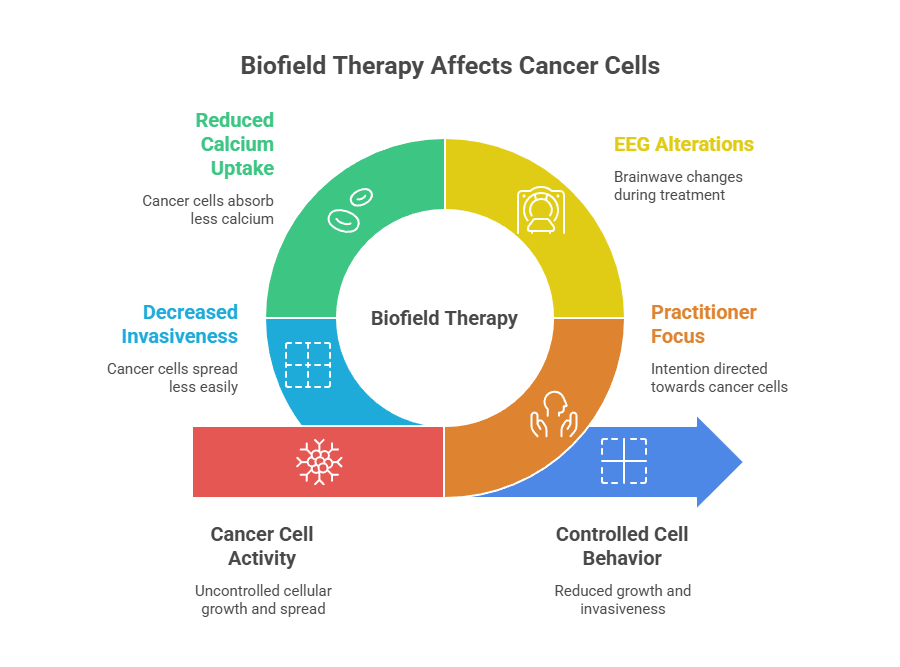
Biofield Research: Can Practitioners Affect Cellular Frequencies?
Controversial but scientifically measured: 2024 research published in Nature Scientific Reports examined whether biofield therapy practitioners could affect cellular behavior through frequency-based interactions.
Study Design and Results
The double-blind study involved 60 sessions with a practitioner treating pancreatic cancer cells:
Measured effects on practitioner:
- Significant EEG alterations in beta and gamma frequencies during treatment
- Decreased parasympathetic activity when treating live cancer cells
- Measurable physiological changes correlated with treatment intention
Effects on cancer cells:
- 66% reduction in calcium uptake (p < 0.0001)
- Significant reduction in cellular invasiveness
- Granger causality analysis revealed bidirectional influences between practitioner physiology and cellular outcomes
Interpretation: While mechanisms remain unclear, this suggests measurable frequency-based interactions between focused human intention and cellular behavior. More research is needed to understand practical applications.
Technologies for Measuring Human Frequencies
Understanding how frequencies are measured helps evaluate claims and research:
| Technology | Frequency Range | Application |
|---|---|---|
| Microcantilever analysis | 1 kHz-1 MHz | Cellular vibration modes |
| EEG (electroencephalography) | 0.5-100 Hz | Brainwave monitoring |
| HRV analysis | 0.04-0.4 Hz | Cardiac coherence |
| GDV/Kirlian photography | Various | Biofield imaging (controversial) |
| Biophoton detectors | Visible spectrum | Cellular light emission |
| Accelerometers (vibration) | 0.1-1000 Hz | Whole-body vibration measurement |
For personal tracking:
- Wearable HRV monitors (Oura Ring, WHOOP, Apple Watch)
- Consumer EEG headbands (Muse, Emotiv)
- Meditation apps with binaural beats (alpha/theta entrainment)
Expert Perspectives on Human Vibrational Medicine
Dr. James L. Oschman, PhD
Biophysicist and author of "Energy Medicine: The Scientific Basis"
"Energy is the currency of all interactions in nature. To leave energetic considerations out of the healing arts is to ignore a fundamental aspect of biology."
His research focuses on bioelectromagnetics and energy field interactions in biological systems, providing scientific frameworks for understanding frequency-based healing.
Dr. Carlo Ventura, MD, PhD
University of Bologna, Italy - Stem Cell Research
Dr. Ventura has pioneered research showing how sound vibration affects gene expression and cellular regeneration at the molecular level, demonstrating frequency-induced stem cell differentiation and providing validation for frequency-based therapeutic approaches.
Dr. Rollin McCraty, PhD
HeartMath Institute Research Director
Dr. McCraty's research on heart rhythm coherence reveals how coherent energy fields generated by the heart influence whole-body frequency patterns and physiological coherence, demonstrating measurable effects of emotional states on bioelectrical activity.
Practical Action Plan: Exploring Your Body's Frequencies
Week 1-2: Begin baseline monitoring
- Download an HRV tracking app (Elite HRV, HRV4Training)
- Record morning measurements to establish your cardiac frequency baseline
- Note correlations with sleep, stress, and activity levels
Week 3-4: Experiment with brainwave entrainment
- Try guided meditation apps with binaural beats (Insight Timer, Brain.fm)
- Focus on alpha (8-13 Hz) for relaxation or theta (4-8 Hz) for creativity
- Document subjective effects and HRV changes
Month 2: Research local frequency therapy options
- Locate wellness centers offering WBV therapy
- Schedule consultation to discuss your specific health goals
- If unavailable, consider home WBV platforms ($300-2,000 range)
Month 3-6: Advanced frequency optimization
- Explore EEG neurofeedback for personalized brainwave training
- Investigate frequency-specific microcurrent therapy for chronic conditions
- Work with qualified practitioners for personalized protocols
Ongoing: Build your frequency awareness practice
- Document responses to different frequency exposures
- Monitor HRV trends over time
- Adjust lifestyle factors that influence autonomic balance
Frequently Asked Questions
What is the exact frequency human cells vibrate at?
According to 2024 research published in PRX Life, living human cells vibrate at two distinct frequencies: 10-30 kHz and 150-180 kHz. These cellular oscillations were measured using microcantilever technology and represent natural mechanical resonance patterns at the cellular level.
Is the 5 Hz whole-body resonance the same as cellular frequency?
No. The 5-12 Hz range refers to mechanical/structural resonance of body tissues when exposed to external vibration. Cellular frequencies operate at much higher ranges (kHz). These are different phenomena measured by different technologies.
Are claims about 62-70 MHz human frequencies legitimate?
No peer-reviewed scientific evidence supports these claims. Legitimate human biological frequencies range from 0.1 Hz to 200 kHz depending on the type (mechanical, bioelectrical, or cellular). The MHz claims appear to originate from unvalidated commercial devices.
Can you really heal with specific frequencies?
Yes, but with important qualifications. Whole-body vibration therapy (10-50 Hz) has substantial clinical evidence for bone density, muscle strength, and neurological benefits. Frequency-specific applications show promise for pain management and certain conditions. However, many frequency healing claims lack scientific support.
How do I know which frequencies are right for me?
This depends on your specific health goals:
- Bone/muscle health: WBV therapy at 20-40 Hz
- Stress reduction: Alpha brainwave entrainment (8-13 Hz)
- Cognitive enhancement: Gamma stimulation (40 Hz)
- Pain management: FSM therapy (consult practitioners)
Always work with qualified healthcare providers for therapeutic applications.
The Bottom Line: What Science Shows About Human Frequencies
Humans vibrate at multiple frequencies simultaneously, each serving distinct biological functions:
- Mechanical body resonance (5-12 Hz): Structural vibrations relevant to therapy and safety
- Bioelectrical activity (0.5-200 Hz): Brain waves, heart rhythms, muscle activity
- Cellular oscillations (10-180 kHz): Recently discovered molecular vibrations
Clinical evidence supports frequency-based therapeutic interventions including whole-body vibration therapy, frequency-specific microcurrent, and brainwave entrainment. However, unverified claims about megahertz frequencies and instant healing lack scientific support.
The future of frequency medicine lies in personalized protocols based on individual bio-resonant profiles, guided by emerging research into cellular mechanotransduction and biofield interactions. As measurement technologies improve, we'll gain deeper understanding of how frequency affects human health at every biological level.
